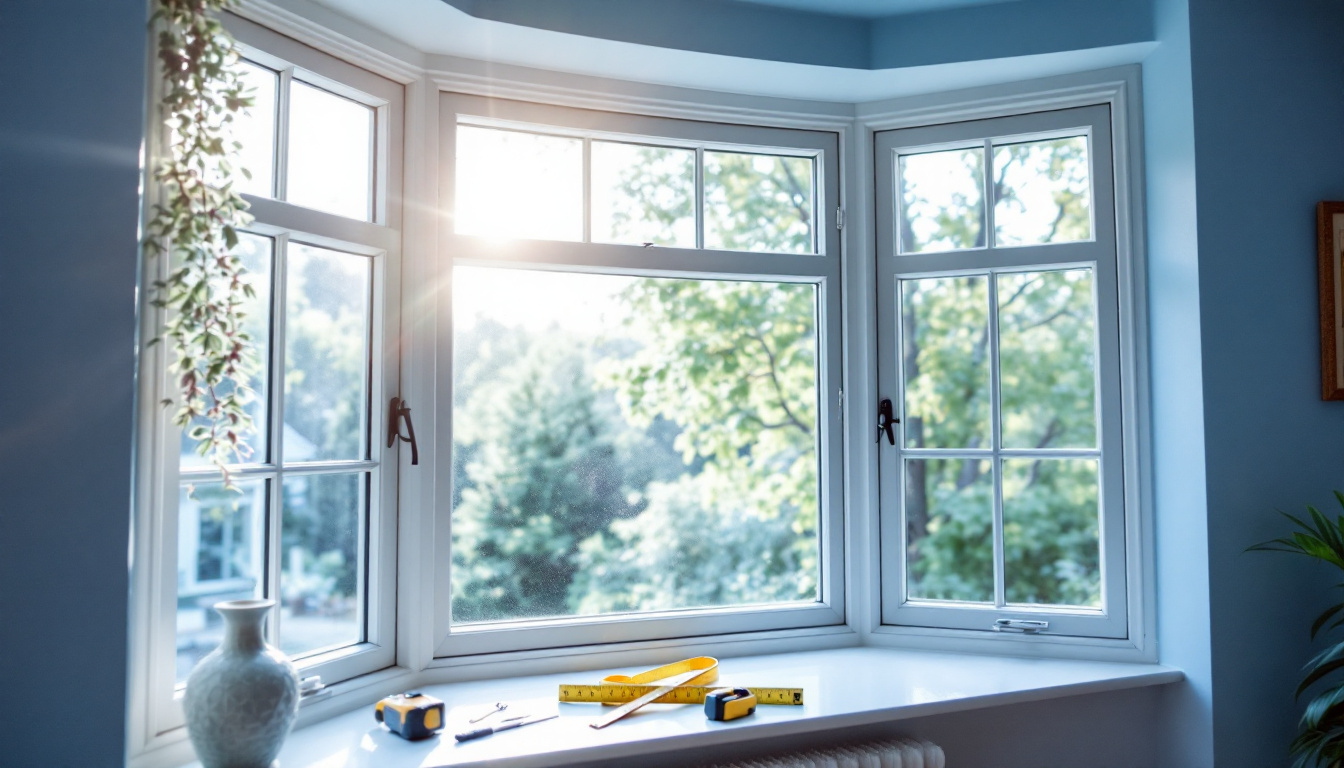Replacing your bow windows is a significant home improvement project that can enhance your home’s aesthetic appeal, energy efficiency, and overall value. However, accurate measurements are crucial for ensuring your new bow windows fit perfectly. This comprehensive guide will walk you through the process of measuring for a bow window replacement, helping you avoid costly mistakes and ensuring a smooth installation process.
Understanding Bow Windows and Why Proper Measurements Matter
Bow windows are curved structures that project outward from your home’s exterior wall, creating an elegant architectural feature that allows more natural light to enter your space. Unlike bay windows, which typically have three panels meeting at angles, bow windows consist of four or more window panels arranged in a gentle curve.
Accurate measurements are essential when replacing bow windows because these custom-made structures require precision. Even small measurement errors can lead to significant installation problems, air leaks, and unnecessary expenses.
The Difference Between Bow Windows and Other Window Types
Bow windows differ from standard windows in several key ways. Their curved design creates a more gradual projection than bay windows, offering a panoramic view and a sense of expanded interior space. This unique structure means that measuring for replacement requires special attention to both the curve radius and the individual window panels.
Unlike flat windows, bow windows interact with both interior and exterior spaces in complex ways. They often include multiple operating panels and fixed panels arranged in a specific configuration, making precise measurements even more critical.
Common Challenges in Bow Window Measurement
Measuring bow windows presents unique challenges compared to standard window replacements. The curved structure means you’ll need to account for both horizontal and vertical dimensions, as well as the projection depth and radius of the curve.
Another common challenge is determining whether to measure the existing frame or the rough opening. In most replacement scenarios, you’ll measure the existing frame, but in cases of significant damage or structural changes, measuring the rough opening may be necessary.
Essential Tools for Measuring Bow Windows
Before beginning the measurement process, gather all the necessary tools to ensure accuracy. Having the right equipment on hand will make the process more efficient and help you avoid measurement errors.
Quality measuring tools are an investment in the success of your window replacement project. Remember that even small measurement errors can lead to significant problems during installation.
Basic Measurement Tools
Start with these essential tools for basic bow window measurements:
- Metal tape measure (at least 25 feet long)
- Carpenter’s level
- Notepad and pencil
- Digital camera or smartphone
- Flashlight
A metal tape measure is preferred over cloth or plastic options because it remains rigid when extended, allowing for more accurate measurements across the curve of the bow window.
Advanced Measurement Tools
For more precise measurements, especially for complex bow window configurations, consider these advanced tools:
- Laser measuring device
- Angle finder
- Digital level
- Compass for measuring the arc
- Template material (cardboard or thin plywood)
A laser measuring device can be particularly helpful for determining the projection depth of your bow window, while an angle finder helps measure the precise angles between window panels.
Step-by-Step Measurement Process
Following a systematic approach to measuring your bow window will help ensure accuracy. Take your time with each step, and don’t hesitate to double-check your measurements before finalizing your order.
It’s recommended to measure each dimension at least twice to confirm accuracy. Small discrepancies in measurements can lead to significant issues during installation.
Measuring the Width
To measure the width of your bow window:
- Measure the total width of the window from jamb to jamb at three points: top, middle, and bottom.
- Record the smallest of these three measurements.
- For replacement windows, measure the width of the existing frame.
- If measuring for a new construction or complete frame replacement, measure the rough opening and subtract 1/2 inch to allow for shimming and insulation.
The width measurement should be taken from the inside of the window frame, not including any trim or casing. This ensures your new bow window will fit properly within the existing opening.
Measuring the Height
For accurate height measurements:
- Measure from the high point of the sill to the top of the window frame.
- Take this measurement at multiple points across the bow window, particularly at each panel junction.
- Record the smallest height measurement to ensure your replacement window will fit.
- If your bow window has a seat board or interior shelf, measure from the top of this surface to the top of the window frame.
Remember that houses settle over time, so it’s common for height measurements to vary slightly across the span of a bow window. Always use the smallest measurement to ensure proper fit.
Measuring the Projection and Depth
The projection of a bow window refers to how far it extends from the exterior wall of your home:
- Measure from the exterior wall to the outermost point of the bow window.
- Measure the depth from the interior wall to the innermost point of the bow window.
- Record both measurements, as they’ll be needed for proper replacement.
- If possible, measure the radius of the curve using a compass or by creating a template.
The projection measurement is particularly important if you have space constraints outside your home, such as walkways or landscaping features that might interfere with the window.
Advanced Measurement Considerations
Beyond basic dimensions, several other factors need to be considered when measuring for a bow window replacement. These details ensure your new window will function properly and integrate seamlessly with your home.
Taking the time to address these additional considerations can prevent costly adjustments during installation and ensure your new bow window performs optimally for years to come.
Measuring Individual Window Panels
Bow windows consist of multiple panels arranged in a curve. To ensure proper replacement:
- Count the total number of panels in your existing bow window.
- Measure the width of each individual panel.
- Note which panels are fixed and which are operable.
- Identify the type of each panel (casement, double-hung, fixed, etc.).
This information is crucial for ordering a replacement bow window with the same configuration as your existing one, or for making informed decisions about changing the configuration to better suit your needs.
Measuring for Energy Efficiency
Outdated bow windows can account for significant energy loss in your home. When measuring for replacement, consider these energy-related factors:
- Check for gaps between the window frame and the wall.
- Measure the thickness of the existing glass (single, double, or triple pane).
- Note any existing Low-E coatings or gas fills.
- Measure the depth of the frame to ensure it can accommodate energy-efficient glass packages.
Modern energy-efficient bow windows can reduce your energy bills by 15-20% annually, making these measurements particularly important for maximizing the return on your investment.
Common Measurement Mistakes to Avoid
Even experienced DIYers can make measurement errors when dealing with the unique challenges of bow windows. Being aware of common mistakes can help you avoid costly errors and ensure a successful replacement project.
Taking the time to verify your measurements and approach the task methodically will save you time, money, and frustration during the installation process.
Measurement Accuracy Issues
Avoid these common measurement pitfalls:
- Measuring from trim to trim instead of jamb to jamb
- Failing to measure at multiple points (top, middle, bottom)
- Not accounting for the curve radius of the bow
- Assuming all panels are the same size
- Rounding measurements instead of recording exact figures
Always measure to the nearest 1/8 inch and record these precise measurements. Window manufacturers need exact dimensions to create a properly fitting replacement.
Documentation Errors
Proper documentation of your measurements is just as important as the measuring process itself:
- Create clear, labeled diagrams of your bow window
- Take photographs from multiple angles
- Note which measurements correspond to which parts of the window
- Keep all measurements in one place
- Double-check your notes for transposed numbers or unclear notations
Consider creating a simple sketch of your bow window and recording all measurements directly on this diagram. This visual reference can be invaluable when communicating with window manufacturers or installers.
When to Consult a Professional
While measuring for a bow window replacement can be a DIY task, certain situations call for professional assistance. Knowing when to call in an expert can save you from costly mistakes and ensure the best outcome for your project.
Professional window installers have specialized tools and extensive experience with complex window configurations like bow windows, making their expertise valuable in challenging scenarios.
Complex Structural Considerations
Consider professional measurement assistance if:
- Your home has settled significantly, creating uneven openings
- The existing bow window shows signs of structural damage
- You’re changing the size or configuration of the window opening
- Your bow window includes complex architectural elements
- You’re unsure about load-bearing considerations
Structural issues can complicate the measurement process and may require expertise beyond basic window measurements. A professional can identify potential problems that might affect the installation.
Benefits of Professional Measurement Services
Many window companies offer professional measurement services, which provide several advantages:
- Guaranteed accuracy and proper fit
- Expert assessment of your existing window condition
- Recommendations for energy-efficient options
- Identification of potential installation challenges
- Manufacturer warranties that may require professional measurements
Professional measurement services often include a detailed assessment of your existing windows, helping you make informed decisions about energy-efficient upgrades that can qualify for rebates and incentives in many regions.
Final Tips for Successful Bow Window Replacement
As you prepare for your bow window replacement project, keep these final tips in mind to ensure a smooth process from measurement to installation. Proper planning and attention to detail will help you achieve the best possible results.
Remember that bow window replacement is a significant investment in your home’s comfort, energy efficiency, and aesthetic appeal. Taking the time to get the measurements right is the first step toward enjoying these benefits for years to come.
Timing Your Measurement and Replacement
Consider these timing factors for your bow window project:
- Measure during moderate weather conditions when the window materials are neither expanded (hot) nor contracted (cold)
- Allow 4-8 weeks from measurement to installation for custom bow windows
- Schedule installation during favorable weather when possible
- Consider seasonal rebates and promotions when planning your project
Many homeowners find spring and fall ideal for window replacement projects, as the moderate temperatures minimize energy loss during installation and provide comfortable working conditions for installers.
Documentation and Communication
Maintain clear records throughout the process:
- Keep copies of all measurements and notes
- Take before photos from multiple angles
- Document any unusual features or concerns
- Communicate specific requirements clearly to manufacturers or installers
- Verify all details before finalizing your order
Clear communication with your window provider or installer is essential for ensuring your new bow window meets your expectations. Don’t hesitate to ask questions or request clarification on any aspect of the measurement or installation process.



